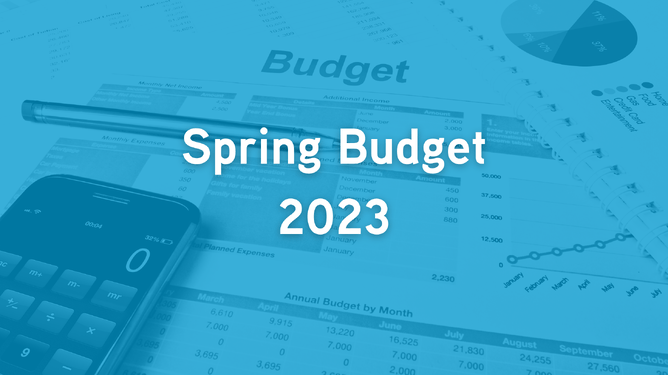Spring Budget 2023 - What you need to know.
Jeremy Hunt announced his second fiscal statement and first Budget since becoming Chancellor against a backdrop of fragile public finances, an ongoing cost of living crisis, and increased Government borrowing.
In January, the Chancellor appealed to the nine million ‘economically inactive’ people in the UK, specifically retirees, claiming: “to those who retired early due to the pandemic, or haven’t found the right role after furlough, I say Britain needs you.”
Ahead of time, then, we expected the Chancellor’s speech – dubbed the ‘back to work Budget’ by the media – to focus on the Government’s economic priorities: halving inflation, growing the economy, and reducing national debt.
With a surprise surplus of £5.4 billion in January due to record self-assessment tax payments, and year-to-date borrowing undershooting the Office for Budget Responsibility (OBR) forecast by £30.6bn, the question has been whether Hunt would pay off some of what the UK owes, or funnel it back into the economy.
With that in mind, the Chancellor’s speech highlighted a plan of two halves: a series of short-term measures designed to provide immediate support to businesses and households, and a longer-term strategy for growth.
But how does his Budget stack up against the Government’s priorities – and what does it mean for people and businesses across the UK?
Business Changes
Capital investment
With the annual super-deduction due to end before the start of the new tax year, the Chancellor has announced that the Government will introduce a “full expensing” scheme to encourage companies to invest in plant, machinery and technology.
From 1 April 2023 until 31 March 2026, companies across the country will be able to claim back 100% of their qualifying costs. For the next three years, the Government says 99% of companies will be able to immediately reclaim every pound invested.
The Chancellor also said the Government plans to make this measure permanent (if the economy allows) post-2026, adding that the policy will make the UK’s capital allowance regime “the joint most generous” of any advanced economy.
He said: “If the super-deduction was allowed to end without a replacement, we would have fallen down the international league tables for tax competitiveness and damaged growth. I could not allow that to happen.”
R&D tax relief
During the Autumn Statement in 2022, the Chancellor announced measures to reduce fraudulent research and development claims by lowering the amount SMEs can claim in R&D expenditure.
In the Spring Budget, however, Hunt said the Government will introduce a new scheme for loss-making, “R&D intensive” SMEs. Companies that spend at least 40% of their total expenditure on R&D will be considered R&D intensive.
These R&D-focused SMEs will be able to claim a higher payable credit rate of 14.5% rather than the reduced 10% announced in the Autumn Statement.
In practice, this means they’ll be eligible to claim back £27 for every £100 they spend.
The changes are part of a £1.8bn support package for development and investment in the UK’s tech-pioneering companies.
Consultations into the merging of the R&D expenditure credit (RDEC) and SME R&D schemes have now closed and all responses are currently under consideration. The Government says this may still be a possibility come April 2024.
Investment zones
The Chancellor followed up with more details on the investment zones announced in November’s Autumn Statement.
The refocused investment zones programme will focus on 12 growth clusters across the UK, including four across Scotland, Wales and Northern Ireland.
Each English investment zone will have access to interventions worth £80m over five years, including tax reliefs and grant funding.
They will be focused on one of a series of key sectors: technology, creative industries, life sciences, advanced manufacturing and the green sector.
Eight areas in England have been shortlisted for the investment zones – the East Midlands, Greater Manchester, Liverpool, the North East, South Yorkshire, the Tees Valley, the West Midlands and West Yorkshire.
The Chancellor said: “To be chosen, each area must identify a location where they can offer a bold and imaginative partnership between local government and a university or research institute in a way that catalyses new innovation clusters.
“If the application is successful, they will have access to £80m of support for a range of interventions including skills, infrastructure, tax reliefs and business rates retention.”
Hunt also set out plans to invest £200m in local regeneration projects across England and £400m for new levelling-up partnerships.
Creative industry expenditure
Creative industries across the UK will receive continued Government support through reformed tax reliefs and expenditure credits.
Expenditure for high-end TV production will remain at £1m per hour. The Government will also extend the higher rates of theatre, orchestra, and museums and galleries tax reliefs for two further years.
Corporation tax rises as expected
As previously announced, the corporation tax rate will increase from 19% to 25% in April 2023 but with marginal relief for businesses with profits between £50,000 and £250,000.
According to Hunt, only 10% of companies will pay the 25% rate, and the UK has the lowest rate of corporation tax in the G7.
Personal Changes
Back to work
The number of 16 to 64-year-olds in employment has failed to return to pre-pandemic levels, with 8.86m “economically inactive” people not currently seeking paid work.
Meanwhile, the number of job vacancies remains high at 1.1m – 328,000 more compared to early 2020 – meaning that fewer people are working and paying taxes than there could be.
To increase worker participation, Hunt announced his plan to “remove the barriers” to work for groups including older workers, parents and people with health conditions, causing many to dub the announcement as a ‘back to work’ Budget.
Pensions lifetime allowance
In the run-up to the Budget, many speculated that Hunt would increase the pensions lifetime allowance (LTA) to allow people to increase the amount they receive in retirement.
Instead, he scrapped the limit altogether, claiming this would incentivise over-50s to work for longer.
The LTA is the total amount you can put in your private pension pot before tax. The cap was due to stay at £1,073,100 until 2026, but workers will now be able to make unlimited pension contributions during their lifetime.
Meanwhile, the annual allowance – the maximum tax-free amount people can pay into private pensions per year – will rise by 50% from £40,000 to £60,000.
According to the British Medical Association, the current LTA rate is “punitive”, and encourages senior doctors to leave the NHS.
Hunt hopes that abolishing the LTA and raising the annual allowance will address doctors’ concerns, as well as encourage older workers across the UK to return to the workforce.
However, some believe that these measures will only benefit top earners.
Expansion of free childcare
The Chancellor also announced significant reforms to childcare to encourage parents to return to work.
Working parents of children aged three to four are currently entitled to 15 hours of free childcare a week, or 30 if both parents are in work and earn at least the national minimum wage. However, the same support is not available for parents earning more than £100,000 a year in combined income.
The Government will expand this support to working parents of children over the age of nine months by September 2025.
Childcare in the UK is among the most expensive in the world, with average full-time nursery fees for a child under two standing at nearly £15,000 a year.
According to the Treasury, increased access to free childcare will reduce discrimination against women, who disproportionately take on care responsibilities, and “benefit the wider economy”.
However, the phased nature of these reforms means they will not come into effect until April 2024 at the earliest, so many parents of young children will not benefit.
The Chancellor also pledged more “wrap-around” care for working parents, bookending school days to allow parents to work longer hours without incurring costly childcare bills.
Returnerships
Hunt will also launch a ‘returnerships’ programme that will offer skills training tailored for the over-50s, taking previous experience into account.
The Government will add a further 8,000 places per year (an increase of 14%) to its ‘skills bootcamps’, which reskill people in sectors such as construction and technology.
Energy support
Following pressure to provide extra support for households struggling with soaring energy bills, the Chancellor announced a three-month extension of the energy price guarantee.
At the moment, the scheme caps the average household’s energy bills at £2,500 a year. This limit was due to rise to £3,000 from April 2023 onwards.
However, Hunt’s announcement means energy bill support will continue at the same levels until the end of June.
Despite previously saying there was “no headroom” for increased energy support, Hunt said: “With energy bills set to fall from July onwards, this temporary change will bridge the gap and ease the pressure on families, while also helping to lower inflation too.”
Customers on prepayment metres will see energy charges brought into line with prices for customers who pay via direct debit. However, the £400 discount from the Energy Bills Support Scheme will end as planned.
We hope that helps!
Please feel free to get in touch if you have any further questions.

